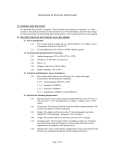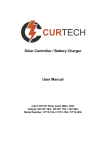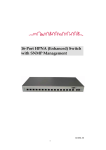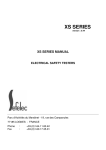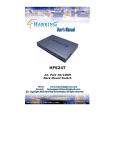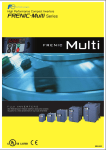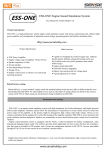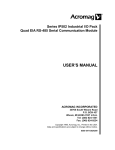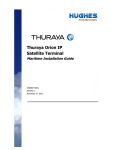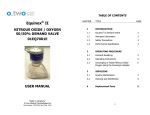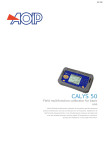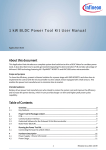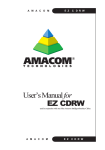Download Recorders - Lesman Instrument Company
Transcript
Specification for Electronic Data Recorder 1.0 GENERAL SPECIFICATION An “electronic data recorder” is required. These recorders are also known as “paperless” or “video recorders”. The primary attributes of these recorders are a Color LCD display, electronic data storage on removable media, and networkable data communications. Data Analysis Software is also required. 2.0 SPECIFICATIONS OF ELECTRONIC DATA RECORDER 2.1 Power Specification: 2.1.1 The recorder shall be available for use with 90-264VAC, 47- 63 Hertz. Power Consumption shall be less than 60 VA. 2.1.2 In some applications 24VAC/DC or 48VDC shall be required. 2.2 Environmental Requirements for Operation 2.2.1 Ambient temperature: 00C to 500C (320F to 1220F) 2.2.2 Vibration: 5 to 100 Hertz, 10 meters/sec2 2.2.3 Shock: 1G 2.2.4 Magnetic Field: 450 AT/M (0- 60Hz) 2.2.5 Relative Humidity: 10% to 90 % 2.3 Standards and Regulatory Agency Compliance 2.3.1 The recorder shall conform to the following. The vendor shall supply documentation that demonstrates compliance. 2.3.1.1 Safety Standard: EN61010-1:1993 2.3.1.2 Immunity: EN50082-2 2.3.1.3 Emissions: EN50081-1 2.3.1.4 Disturbances: EN60555-2 and EN600555-3 2.4 Physical and Mounting Requirements 2.4.1 Bezel and Cutout: The recorder bezel and cutout shall be designed to replace 100mm type paper recorders; the bezel size: 300 mm. x 300 mm. (11.81” x 11.81”) and shall fit into a 281mm x 281mm. (11.06” x 11.06”) cutout. 2.4.2 Construction: The front bezel shall be made from flame retardant materials. The recorder case shall be of metal construction. 2.4.3 Display: The display shall be no less than 12.1 inches diagonally and utilize Digital TFT LCD technology. Resolution: 800 x 600 pixels 2.4.4 Length: The recorder shall be no more than 205 mm. (8.07’) in length. 2.4.5 Mounting Angle: The instrument shall be mountable at angle up to 65 degrees upward from horizontal and 40 degrees downward from horizontal with no impairment on the operation of the storage device. 2.4.6 Operator Keys: The recorder shall be equipped with a touch screen interface that provides easy navigation through the operator displays and menus. Page 1 of 10 A means of rapid menu navigation and selection shall be available to review historic trend data and system messages. This device shall be intuitive by design. A means of entering alphanumeric data that is intuitive and does not require any peripheral equipment shall be included. Unique and spontaneous operator comments shall be accommodated and integrated with other system messages. 2.4.7 Visibility: Critical data should be visible at distances of ten feet. Line thickness and numeric data should be configurable to accommodate this need where required. When an alarm is in force, an operator should be alerted by color change or other posting that would be visible from a distance of ten feet. 2.4.8 Electrical connections: Termination shall be made from the rear of the recorder. These connections shall be made using quick disconnect terminals. Change-out of a recorder shall not require termination of field wiring. 2.4.9 Communications: Ports shall be accessible from the rear of the recorder. EIARS485 (2 wire) and Ethernet 10/100BASE T shall be included standard on the product. The Ethernet port shall comply with the IEEE 802.3 standard. 2.5 Input /Output Requirements 2.5.1 The recorder shall be supplied with Analog Input circuitry that will resolve the analog field signals to 16 bits of resolution. The input circuitry should be configurable to accommodate various signal types on the same card. This type of input card is often called a Universal Analog Input Card. Up to 48 analog channels will be required for the relevant applications. 2.5.2 Signals types: 2.5.2.1 Current types: 0-20 ma, 4-20ma, Accuracy: +0.2% full scale or better 2.5.2.2 Voltage types: +10mV, +50mV, +100mV, +500mV, +1Volt, +6Volts +12Volts; +25Volts, +50Volts Accuracy: + 0.1% full scale or better. 2.5.2.3 Thermocouples: K, R, S, B, J, T, E, and N types shall be configurable. Characterization shall be in accord with the International Thermocouple Tables. Burnout indication is required. Accuracy: + 0.1% of span or better. 2.5.2.4 RTD: PT100, PT200, PT500, PT1000, 100Ω Nickel, 120Ω Nickel, 10Ω Copper, 53Ω Copper, Resistance up to 4000 Ω 2.5.2.5 Frequency input of 1 Hz to 25,000 Hz 2.5.2.6 Digital Input: Dry contact 2.5.2.7 Alarm Outputs: “C Form” relays, NO/NC, 3 ampere 240VAC rating, minimum. 2.5.2.8 Analog outputs capable of re-transmitting selected signals shall be 4-20 ma/0-20ma. At least 4 analog outputs shall be available. 2.5.3 Auxiliary Power Supply: An isolated 24VDC-power supply shall be supplied for each channel for field transmitter power (1.0 amps max.) 2.6 Display & Presentation Technology Page 2 of 10 2.6.1 A custom screen building engineering tool that permits the development of screens is strongly preferred. 2.6.2 Screen creation shall not require vendor firmware or vendor software engineering. All design and modifications of the screens shall be achieved by using a graphic building software tool. The software shall be suitable for use by the end user. 2.6.3 A graphic change shall not affect the manufacturer’s firmware revision. Screen changes shall not require re-certification of the recorder. 2.6.4 The vender’s authorized representative shall demonstrate upon request, how these screens can be created and modified. Modification shall not require a firmware modification by the vendor or a vendor supplied software download. Modification of any screen format shall be achieved at the site with minimal interruption of data acquisition. 2.6.5 Screens objects: Each display requires a mix of various display formats or objects that can be combined to meet the operator’s needs. Color coding of bar indicators, trend lines, numeric displays, and other graphic elements shall be fully configurable. 2.6.6 Screen Content: All Events that pertain to a pen shall be displayed on the trend graphs in which the pen is included. 2.6.7 Chart displays shall have adjustable chart speeds. Chart speeds of 1 millimeter per hour to 6,000 millimeters per hour shall be selectable without access to configuration tools or interruption of data collection. 2.6.8 Screen Update: The display shall update a minimum frequency of once per second. 2.6.9 All events shall be posted on an audit trail display with the associated time and date stamp. This display shall be accessible easily using the touch screen or keyboard or mouse via the USB port. The event listing shall provide a utility for scrolling through the listed events. 2.6.10 Display screens shall be saved on a removable media for archive purposes. A utility to save and copy the screen graphics to another recorder shall be provided. 2.6.11 A calibration screen shall be provided. The calibration screen shall include instructions and intuitive graphics to support calibration procedures. This screen shall not require a vendor firmware change to adjust the screen to a specific application. 2.6.12 Screen Time-Out: The recorder’s display will revert back to a default screen after a pre-set amount of time has transpired without operator activity. The time out shall be capable of being set for shift type operations, on during the shift but the screen time out active outside the defined shift hours. 2.7 Recorder Software, and Functions 2.7.1 General 2.7.1.1 Once configured, the recorder shall operate as a stand alone data acquisition device. The operation of the recorder shall not be dependent on external hardware or software to capture and store data for the process. The operator shall have full operational access from the recorder’s HMI and/or operating devices affixed to the recorder itself. Page 3 of 10 2.7.1.2 The recorder shall commence full operation, (“boot-up”,) in less than 30 seconds. 2.7.1.3 Recovery from Power loss: the recorder shall resume data collection with 15 -20 seconds after a power outage. It should be assumed that no UPS (Un-interruptible Power Supply) will be available. 2.7.1.4 Internal Real Time Clock: The clock shall be accurate to 30 parts per million or better. 2.7.1.5 The real time clock shall accommodate Daylight Saving Time. No data shall be lost due to time overlaps or gaps created during clock changeovers. 2.7.2 Operations Technology 2.7.2.1 Language: The recorder is to support multiple languages - English, German, and French 2.7.2.2 Hierarchical Menus with intuitive prompts and selection are preferred. 2.7.3 Data Base Configuration 2.7.3.1 Analog Input Channels: The attributes of each analog input channel shall be menu selectable. Input type, units, and options. A minimum of 10 characters is required for the tag name. 2.7.3.2 Pens: A data pointer or Pen shall be configurable to include math expressions, color assignment, and trend line thickness. Alarm limits shall be configurable. Pens shall also be directly assignable to an analog Input channel. Each pen shall have an independent scaling legend. A 20-character tag name shall configurable to the Pen. 2.7.3.3 Logging rate: Each Data point shall be configurable for an independent logging rate. Rates shall be selectable from various time ranges. The sample rates shall range from milliseconds, seconds, minutes, hours, to days. 2.7.3.4 Math: a complete set of mathematical operations shall be configurable to each pen or data pointer. Math functions to be included are add, multiply, subtract, divide, sine, cosine, tangent, arcsine, arccosine, arctangent, square root, natural logarithm, exponential function, absolute value, parenthetical, and rolling average. 100 characters of math expression shall be provided. 2.7.3.5 The recorder will be capable of supporting a Math Scripting language that allows the recorder to do logical decisions based on various input conditions. 2.7.3.6 Events: The recorder shall be capable of causing certain actions to occur based on various events which are configurable by the users: Causes include Into Alarm, Out of Alarm, Start, Stop and Reset Totalizers Digital Inputs On, Off or Change State and Thermocouple Burnout. Effects include Chart marking with a defined message, start and stop totalizing, Start and Stop Logging, output relay activation, and Alarm Acknowledge. 2.7.4 Recording: Data Acquisition 2.7.4.1 Scanning and Sampling Methods 2.7.4.1.1 Scanning and Sampling Rate: Data scanning and sampling shall be collectable at a rate of 20 milliseconds or 50 hertz for Page 4 of 10 linear input signals. Data shall be written to the storage media with a resolution of 20 milliseconds. Each datum shall be time and date stamped. 2.7.4.1.2 Minimum- Maximum Mode: A selection to capture the minimum and maximum value between logged points shall be required. The recorder shall capture the highest and the lowest value detected during the sample interval to a resolution of 20 milliseconds. At the end of the sample interval both values are logged to the data storage media. The shortest sampling interval shall be 20 milliseconds. 2.7.4.1.3 Average Mode: A selection to collect the average value during a sampling interval shall be required. In this mode the average of the sample interval is logged. 2.7.4.2 Audit Trail (on recorder) 2.7.4.2.1 Events logging: A utility to record all events shall be provided. Events are to include system messages, operator actions, alarms, configured events, diagnostic messages, etc. 2.7.4.2.2 Alarms: All alarms shall be logged. The log shall include alarm occurrence and alarm clearing. 2.7.4.2.3 Manual entries: Operators shall a have a means to enter comments. A keyboard should not be required, but there must be a provision to use an external keyboard. 2.7.4.2.4 Data Integrity: All data shall be unalterable by any normal means. Data log files shall be encrypted. 2.7.4.2.5 Data Security: Any changes to the Set-up files shall be protected by password. Each password shall be assigned a level of privilege that authorizes the user for access to specific recorder functions. The access by an operator to secured functions shall be logged. 2.7.4.2.6 Any change to the configuration or set-up shall be logged on the storage media along with the trend and event history. 2.7.4.2.7 Operator Notification- A message or icon shall alert the operator as the data storage status of the data buffer. A message or graphic that informs the operator of the remaining capacity is preferred. 2.7.5 Recording: Archival Data Structure 2.7.5.1 Stored data shall be recorded as a true archival database. The archived data shall be stored in a Contiguous File Structure. Data shall not be segmented into separate files or folders. Transitions for day to day and hour to hour shall be seamless. Each data record shall be item and date stamped. 2.7.6 Security: Password and Definition of Users 2.7.6.1 Access Levels: A least five levels of access shall be provided. 2.7.6.1.1 Administrator: Users with this level of access have full access to all areas and functions including the clearing of all passwords. Page 5 of 10 2.7.6.1.2 Engineer Level: Users with this level of access have full access to all areas and functions except the clearing of passwords. 2.7.6.1.3 Supervisor level: has access to all areas designated for Supervisor access and by default shall have access to areas available to the Technician and Operator levels. 2.7.6.1.4 Technician: has access to all areas designated for Technician access and by default shall have access to areas available to Operator level. 2.7.6.1.5 Operator: access to unsecured areas and Alarm acknowledgement, set point changes, Batch Control and Recording function based on password access. 2.7.6.2 Secured Areas: 2.7.6.2.1 The following areas shall be independently secured. Web Access, Remote Viewing, Messages, Screen functions, Status, View Totals, View Alarms, View Min/Max, Acknowledge Alarms, Configure Alarms, Batch Control, Recording, Configure Totals, Configure Min/Max, Load/Save Setups, Main Menu, Setup Menu, Edit Setup, General menu, Printer set up, Batch Setup, Configure Settings, Configure Layout, screen setup, Pens, General (all), Comms, Comms-Modbus, Comms-Web, Coms-SNTP, Comms-Ethernet, Field I/O and Passwords. 2.7.6.2.2 Security shall be defined by the Administrator. The Administrator shall be able to assign a security level to each area consistent with section 2.7.6.1 2.8 Recorder Data Storage 2.8.1 Internal Memory: The recorder shall have a minimum buffer memory of 70 Megabytes. This will be capable of being partitioned between display buffered data and data for archiving to the media. 2.8.1.1 The buffer memory shall not require a battery back up to insure data retention in the event of any power loss. 2.8.1.2 The vendor shall provide information on the archive capacity of the buffer area of the Internal Memory. 2.8.2 Long term Archive Storage 2.8.2.1 Media: Mass storage media shall be capable of accepting Compact Flash card up to 2.0 Gigabytes. 2.8.2.2 A redundant storage capability shall be available. 2.8.2.3 Removable media components: The media shall be commercially available and not unique to the recorder manufacturer. The media shall not require any special preparation other than routine formatting before use. Commercially available preformatted media is preferred. 2.8.3 Compression algorithms: The vendor shall describe any data compression algorithms that are available for use to compact data storage. The vendor may not assume the use of compression algorithms when calculating buffer or storage capacity as required in sections 2.8.1 and Error! Reference source not found.. Page 6 of 10 2.9 Software Qualification ( Personal Computer Development and Analytical Tools) 2.9.1 All software referred to in Section 2.5 refers to software that would be installed in the user’s personal computer. These specifications shall be applied to software that is used to configure the recorder, and analyze recorder data. 2.9.2 All application software shall be supplied directly from the recorder manufacturer. 2.9.3 Application software used for the creation of screens, database building, hardware configuration, logic and math, history analysis shall be classified as application software. 2.9.4 All applications intended for operation on a Personal Computer shall operate within Window NT version 4.0, service Pack 6 or higher, Windows 2000, or Windows XP. Proprietary operating systems are not acceptable. 2.9.5 Process History files shall be exportable to and compatible with other Microsoft Windows applications, namely, Microsoft Excel. 2.9.6 The software shall support messaging via email. SMTP is acceptable. Microsoft Outlook is preferred. 2.9.7 The vendor shall provide information regarding the revision history of each software application. 2.9.8 The vendor shall provide information on the time that the applications have been in use by other in process connected applications. 2.9.9 Software shall be provided on CD for installation. Downloadable Internet sources of the application software should be identified. 2.9.10 Revision Management: The vendor shall define and propose a methodology for revision and updates. The vendor shall describe the means of notification for new revisions, and define the procedure for delivery of software revisions. A distinction should be made between Enhancements and Maintenance Revisions. 2.9.10.1 Enhancements are defined as software revisions that add functionality or improve product performance, but do not directly affect the safety of operational integrity of the installed recorder or its associated software. 2.9.10.2 Maintenance Revisions are defined as software changes developed to fix any product flaw or update the software to be compatible with other software products. (Example: Updating the application for a new version of Windows or a revised communication standard.) 2.9.11 The vendor shall describe the quality methodology used to develop software. 2.9.12 The vendor shall supply all applicable certificates and documents that attest to level of compliance with any appropriate industrial or professional standards. Independent audits are the most credible. 2.10 Communications 2.10.1 The equipment shall be Ethernet (IEEE 802.3) compatible and support TCP/IP. 2.10.1.1 Physical: 10/100 BASE T shall be supported directly from the recorder. 2.10.1.2 TCP/IP: Transmission Control Protocol/ Internet Protocol shall be supported. IP addresses shall be assigned to each recorder. 2.10.1.3 IP resolution: The unit shall accommodate FIXED and DHCP. 2.10.1.4 FTP: File transfer Protocol shall be provided. Page 7 of 10 2.10.1.5 Recorders shall be accessible through network routers. 2.11 Networking Application Software 2.11.1 Physical Layer standards. 2.11.1.1 Ethernet, IEEE 802.3, shall be supported. 2.11.2 Protocol Standards 2.11.2.1 TCP/IP and FTP shall be supported. 2.11.3 Software Utilities shall use Microsoft Dialog Boxes, (i.e., no command text strings.) 2.11.3.1 Alias or DNS (Domain Name Service) names shall identify recorders. IP addressees shall be retained in a “look-up” listing. 2.11.3.2 A data transfer scheduler shall be provided. The scheduler will initiate data transfers over the network at predefined times. 2.11.4 Multiple Users shall be supported within a networked environment. Each User shall have access to the archive records. 2.11.4.1 A login-password utility shall be included. The administrator shall have the ability to create user profiles with enumerated permissions to specific functions and data. 2.11.5 A network-connected user shall have the ability to import copies of the archive data without impairing the integrity of the original encrypted data. 2.11.5.1 The user shall have the ability to view archive data simultaneously from multiple recorders on the graphic trend-analysis tool. 2.11.5.2 Each user shall have access to the recorder’s set-up and data base functions using a browser. 2.11.6 The recorder shall have the capability to export data to other computer systems. 2.11.6.1 A utility that permits automated transfers on a predetermined schedule shall be provided. FTP shall be supported. 2.11.6.2 The scheduler shall have the ability to define the date, day, time, and source of the data transfer. Recurring schedules shall be supported. 2.11.7 There shall be no limit to the number of recorders that can be connected to a network. IP addressing shall be the only limiting factor. 2.11.8 The data on the Host or Server PC shall be accessible by other client PC’s. 2.11.9 Clients PC’s shall have the ability to access a data server over the World Wide Web or Internet. 2.11.10 A complete Audit Trail shall be logged that documents user access and all system events that may affect the integrity of the data or the system. User, time, date, and event shall be captured in a non-cryptic format. Events shall include, all set-up changes to the recorders, all data imports and exports, system changes, device additions and deletions, operational setting changes. All information related to user log-ins, passwords, etc. shall be logged in the Audit trail. 2.11.11 There shall be a utility that synchronizes the clocks of all recorders within the networked system. 2.11.12 Software Upgrades for the recorders and associated software shall be downloadable by Internet access. Page 8 of 10 2.12 Analysis Software 2.12.1 Trend analysis software shall be provided that will permit the user to review archived process data as recorded. 2.12.2 The trend analysis viewing software shall provide multiple viewing formats that will permit the user to time synchronize archive data. 2.12.3 Data shall be collected by the recorder and transferred to a PC for analysis using removable media such as Compact Flash or USB Memory key. Data shall also be transferable via network connection. 2.12.4 The archive analysis software shall provide a utility for the transfer of archive data in Spreadsheet format. Microsoft Excel 97 or later compatibility is required. Data types shall include trend data, totalizer data, and event data. 2.12.5 The Trend analysis software shall permit the user to build graphs using drag and drop operating technology. Data trends shall be selected from pick and place lists. 2.12.5.1 The software shall permit any combination of pens from the archive files. 2.12.5.2 The software shall permit selectable scaling of the axes. 2.12.5.3 The software shall provide a means of naming each graph. 2.12.5.4 Graphs shall be exportable to excel spreadsheets. 2.12.5.5 Graphs shall be printable directly for the analysis software. 2.12.5.6 The software shall permit the viewing of the trend data in a tabular format, including value, time and date stamp. 2.12.6 Navigation tools shall be provided that enable “find” and “zoom” on the vertical value axis to magnify the variations of the trend line. 2.12.7 Navigation tools shall be provided that enable “find” and “zoom” on the horizontal time axis to magnify variations. The tool shall permit zooming from time periods of seconds to minutes to hours using “click and drag” mouse technology. 2.12.8 The graphs shall display actual data sample measurements by displaying dots or markers on the trend line. 2.12.9 Events shall be displayed on the graph with full text descriptions. Events shall be time linked with the trend data. 2.12.10 A utility to add comments to specific times shall be provided. Once a comment has been added, it shall be an unalterable modification of the graph. 2.13 Documentation 2.13.1 A User Manual shall be provided with each recorder that addresses the operation, configuration, maintenance, and software operation. 2.13.2 The configuration shall be retained on removal media such as compact flash or USB memory key. 2.13.3 The recorder will have contextual Help documentation accessible from various recorder screens. 2.14 Training and Technical Support 2.14.1 The vendor shall include a description of the services available for operator and technician training. Page 9 of 10 2.14.2 The vendor shall describe the services available for ongoing technical and application support. 3.0 Bid Documentation 3.1 The vendor shall provide a complete specification and description of his offering. Specific model numbers and options required to meet this specification shall be included. 3.2 The vendor shall note by paragraph any deviation from these specifications. A description of the deviation shall be included, if appropriate, so that the buyer can fully appreciate the impact and value of each exception. 3.3 Exceptions to this specification that are not identified will result in disqualification of the vendor’s bid. 3.4 Any relevant information or documents that may assist the buyer in evaluating the suitability of the proposed instrumentation is should be included. Certificates of compliance, site references, and applications notes may be included. 4.0 Buyers Qualification Checklist. 4.1 The following is to be completed by the buyers as a critical item checklist. This list addresses the minimum requirements of the recorder specifications. This checklist is intended to provide the buyer a means of quickly determining the suitability of the bidder and the equipment offered. 4.2 Ratings: An answer of Yes means that the vendor’s offering fully meets the requirement. An answer of NO means that the vendor’s offering fails to meet the requirement. 4.3 What is the minimum scan rate? __________ 20 milliseconds or less? Yes or No 4.4 What is the minimum logging rate? ________ 20 milliseconds or less? Yes or No Yes or No 4.5 Is the recorder qualified for seismic application? 4.6 Will the standard product offering require modification to meet the graphic requirement specified in Section 2.6? Yes or No 4.7 How accurate is the internal clock? __________ (30 parts per million?) Yes or No 4.8 Does the real time clock accommodate Daylight Savings Time? Yes or No 4.9 Are events integrated with trend data? Yes or No 4.10 Can an operator enter an original comment into the event log? Yes or No 4.11 Can the recorder be secured by multiple password access? Yes or No 4.12 Can data be stored to multiple removable media types? Yes or No 4.13 Is the archive file structure contiguous? (rather than segmented.) Yes or No 4.14 Does the recorder support Ethernet and TCP/IP? Yes or No 4.15 Does the recorder support RS485 Modbus? Yes or No 4.16 Does the data analysis software export archive files in Microsoft Excel? Yes or No 4.17 How many recorders will the network data server software support? ____________________ 4.18 How many PC clients will the network data server software support?____________________ 4.19 Does the manufacturer provide telephone application assistance? Page 10 of 10 Yes or No










